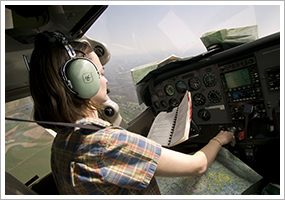| The following stories from the October 16, 2009, edition of AOPA ePilot were provided to AOPA members who expressed an interest in the particular subject areas. Any AOPA member can receive information tailored to their areas of interest by updating their preferences online. - My ePilot — Recreational Interest -WAI scholarships aren’t just for studentsWomen in Aviation International would like you to know that you don’t have to be a college student—or a woman—to apply for one or more of its 2010 scholarship offerings. The scholarships for 2010 total more than $300,000 and include financial assistance for dispatcher training; Airbus and Boeing type ratings; jet transition courses; sport, recreational, or private certificates as well as advanced certificates and ratings; and more. Read more >> - My ePilot — Turbine Interest -CitationShares now ‘CitationAir by Cessna’The economic downturn has hit fractional ownership firms especially hard. In August, fractional giant NetJets announced the retirement of its founder, and then came the announcement that 5 percent of NetJets employees would be subject to layoffs. It’s all part of a series of reorganizations and tactical shifts within the once-burgeoning fractional market. Increasingly, owners are shedding their shares and switching to less financially burdensome methods of business travel. On Oct. 9, CitationShares announced that it was re-launching its business under the name CitationAir by Cessna in order to evolve with its customers. Read more >> - My ePilot — Helicopter Interest -Night Flight Concepts receives Part 141 approvalPort St. Lucie, Fla.-based Night Flight Concepts has announced FAA Part 141 approval for night vision goggles (NVG) initial, recurrent, and instructor pilot courses. Currently, FAA Part 141 NVG training may be conducted in the Bell 206 and Robinson R44 at the Palm Beach, Fla., location. FAA Part 141 NVG courses offered by Night Flight Concepts are part of a strategic partnership between Night Flight Concepts and Palm Beach Helicopters. Read more >> TRAINING TIPsFlying ‘hands off’ The Oct. 9 “Training Tip” described the link between a properly located center of gravity (CG) and an aircraft’s longitudinal stability. It made the point that an aircraft’s stability allows it to be trimmed so that it will maintain straight-and-level flight with hands off the controls. Do you seek hands-off flight as a matter of course? Knowing that you can trust your aircraft to maintain airspeed and altitude without a lot of needless waggling and retrimming demonstrates that you are applying basic aerodynamic principles to aircraft control. Equally important, establishing hands-off flight reduces pilot workload, enabling you to divide your attention between other tasks such as communication and navigation. And that’s a practical test requirement! The airplane will work with you—and realizing that is one of the wonderful early insights that make order out of sensory chaos. “Think back to those first few flight lessons. Striving mightily to learn a fundamental skill such as straight-and-level flight, most student pilots first commit the common errors of fixation, forgetfulness, and faintheartedness. They’re overwhelmed by the workload; the airplane is flying them. This quickly changes for the better. The student learns to trust the airplane to be predictable, not predatory. That insight instills confidence, which allows the student to divide attention between tasks such as setting airspeed, maintaining altitude, and holding a heading,” Dan Namowitz wrote in the September 2008 AOPA Flight Training feature “ Short and Soft: Sometimes you have to combine your skills.” Be patient with your aircraft. Overcontrolling is at the root of much imprecision. “If the trimming process occurs too quickly—which students tend to do—it becomes a difficult task. When trimming, wait a moment or two for airspeed and power to stabilize before you fine-trim the elevator. After that adjustment, again wait for a moment or two and reevaluate the need for additional pitch trim,” Ralph Butcher wrote in “ Insights: Confidence maneuvers.” Also, “Relax!” That word was the title of the Dec. 22, 2006, “Training Tip,” which reminded pilots, “Teaching yourself to relax while flying is more than just psychologically comforting—it makes you fly better.” TRAINING PRODUCTSKing Schools updates ‘Flying the Garmin G1000’King Schools Inc. has released Version 8 of its Cleared for Flying the Garmin G1000 course. The updated course now includes autopilot and WAAS functions, and discusses improvements made to the "flight plan" and "direct to" windows, the primary flight display status bar, and the way navigation modes are displayed on the HSI, among others. The course is designed to be used on a personal computer and sells for $249. Order online or call 800/854-1001.
Note: Products listed have not been evaluated by ePilot editors unless otherwise noted. AOPA assumes no responsibility for products or services listed or for claims or actions by manufacturers or vendors. FINAL EXAMQuestion: I am considering forming a flying club. What resources does AOPA have to help me with this process?
Answer: A flying club is a great way to reduce the individual expense of aircraft ownership. AOPA has an online section full of flying club information. You’ll find tips on organizing and managing the club, suggestions on purchasing club aircraft, and help with calculating operating costs, taxes, and insurance. AOPA’s Tips on Buying Used Aircraft can help you through the purchasing process; other AOPA membership services can help with financing, insurance, and legal advice. Got a question for our technical services staff? E-mail to [email protected] or call the Pilot Information Center, 800/872-2672. Don't forget the online archive of "Final Exam" questions and answers, searchable by keyword or topic. |



